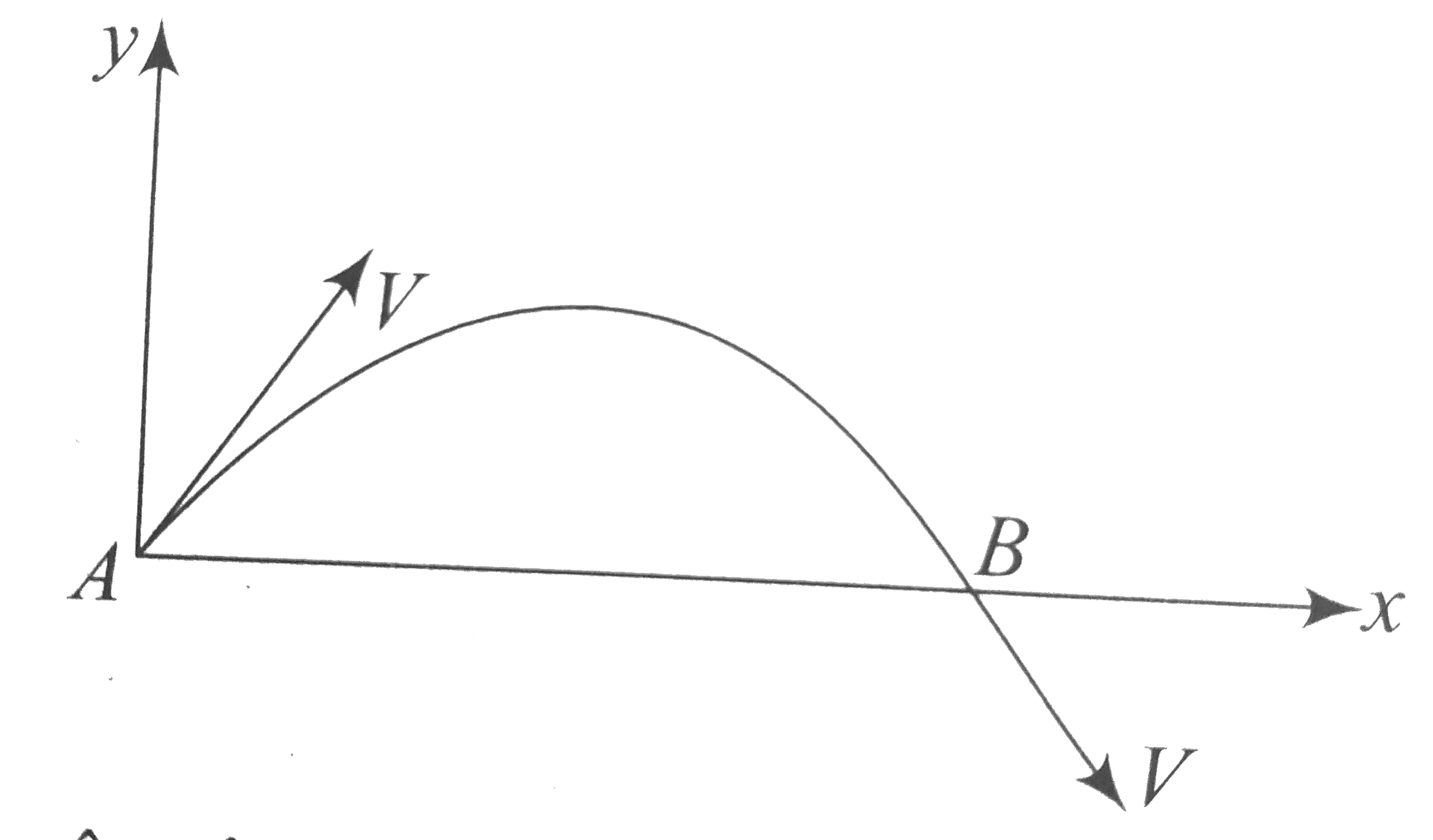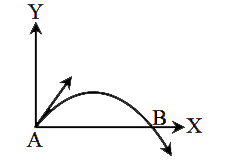At time t=0, particle A is at (1m,2m) and B is at (5m,5m). Velocity of B is (2ˆi+4ˆj)m/s Velocity of particle A is √2v) at 45∘ with x-axis. A collides with B .
Time when A will collide with B is …….second.
0.5s
1.5s
4s
3s
The correct Answer is:A
To solve the problem of when particle A will collide with particle B, we can follow these steps:
Step 1: Determine the initial positions of particles A and B.
- Particle A is at the position (1m,2m).
- Particle B is at the position (5m,5m).
Step 2: Determine the velocities of particles A and B.
- The velocity of particle B is given as →VB=2^i+4^jm/s.
- The velocity of particle A is given as √2v at an angle of 45∘ with the x-axis. We can break this down into components:
- VAx=√2vcos(45∘)=√2v⋅1√2=v
- VAy=√2vsin(45∘)=√2v⋅1√2=v
- Thus, the velocity of particle A can be expressed as →VA=v^i+v^j.
Step 3: Calculate the relative velocity of B with respect to A.
- The relative velocity →VBA is given by:
→VBA=→VB−→VA=(2^i+4^j)−(v^i+v^j)=(2−v)^i+(4−v)^j
Step 4: Determine the distance between A and B at t=0.
- The distance d between A and B can be calculated using the distance formula:
d=√(5−1)2+(5−2)2=√42+32=√16+9=√25=5m
Step 5: Calculate the angle of approach.
- The angle θ of approach can be calculated using the tangent function:
tan(θ)=34
- This indicates the direction in which A is approaching B.
Step 6: Set up the equation for collision.
- For A to collide with B, the relative velocity must be directed towards B. Thus, we need to ensure that the components of the relative velocity align with the direction of the distance vector from A to B.
- The distance vector from A to B is (4,3).
Step 7: Calculate the magnitude of the relative velocity.
- The magnitude of the relative velocity |→VBA| is given by:
|→VBA|=√(2−v)2+(4−v)2
Step 8: Calculate the time until collision.
- The time t until collision can be calculated using:
t=d|→VBA|=5|→VBA|
Step 9: Solve for v such that |→VBA| is maximized.
- To find the value of v that satisfies the conditions for collision, we can set up the equations based on the relative velocities and solve for v.
Step 10: Substitute v and calculate t.
- After determining v, substitute it back into the equation for |→VBA| and calculate the time t.
Final Answer:
After performing the calculations, we find that the time when A will collide with B is 0.5seconds.
---
- Particle A is at the position (1m,2m).
- Particle B is at the position (5m,5m).
- The velocity of particle B is given as →VB=2^i+4^jm/s.
- The velocity of particle A is given as √2v at an angle of 45∘ with the x-axis. We can break this down into components:
- VAx=√2vcos(45∘)=√2v⋅1√2=v
- VAy=√2vsin(45∘)=√2v⋅1√2=v
- Thus, the velocity of particle A can be expressed as →VA=v^i+v^j.
- The relative velocity →VBA is given by:
→VBA=→VB−→VA=(2^i+4^j)−(v^i+v^j)=(2−v)^i+(4−v)^j
- The distance d between A and B can be calculated using the distance formula:
d=√(5−1)2+(5−2)2=√42+32=√16+9=√25=5m
- The angle θ of approach can be calculated using the tangent function:
tan(θ)=34
- This indicates the direction in which A is approaching B.
- For A to collide with B, the relative velocity must be directed towards B. Thus, we need to ensure that the components of the relative velocity align with the direction of the distance vector from A to B.
- The distance vector from A to B is (4,3).
- The magnitude of the relative velocity |→VBA| is given by:
|→VBA|=√(2−v)2+(4−v)2
- The time t until collision can be calculated using:
t=d|→VBA|=5|→VBA|
- To find the value of v that satisfies the conditions for collision, we can set up the equations based on the relative velocities and solve for v.
- After determining v, substitute it back into the equation for |→VBA| and calculate the time t.
After performing the calculations, we find that the time when A will collide with B is 0.5seconds.
Topper's Solved these Questions
- KINEMATICS 1BOOK - DC PANDEY ENGLISHCHAPTER - KINEMATICS 1EXERCISE - MATCH THE COLUMN
10 Videos
- KINEMATICS 1BOOK - DC PANDEY ENGLISHCHAPTER - KINEMATICS 1EXERCISE - INTEGER_TYPE
15 Videos
- KINEMATICS 1BOOK - DC PANDEY ENGLISHCHAPTER - KINEMATICS 1EXERCISE - MCQ_TYPE
27 Videos
- KINEMATICSBOOK - DC PANDEY ENGLISHCHAPTER - KINEMATICSEXERCISE - INTEGER_TYPE
10 Videos
- LAWS OF MOTIONBOOK - DC PANDEY ENGLISHCHAPTER - LAWS OF MOTIONEXERCISE - Medical entrances gallery
39 Videos
Similar Questions
At time t=0, particle A is at (1m,2m) and B is at (5m,5m). Velociyt of B is (2ˆi+4ˆj)m/s Velocity of particle A is √2v) at 45∘ with x-axis. A collides with B .
Value of v is ………..m/s
View SolutionA particle is moving in x-y p1ane.At time t=0, particle is at (1m,2m) and has velocity (4ˆi+6ˆj)m/s. At t=4s, particle reaches at (6m,4m) and has velocity (2ˆi+10ˆj)m/s. In the given time interval, find
(a) average velocity,
(b) average acceleration and
(c) from the given data, can you find average speed?
View SolutionThe velocity of a projectile at the initial point A is (2ˆi+3ˆj)m/s. Its velocity (in m/s) at point B is

View SolutionThe velocity of a projectile at the initial point A is (2ˆi+3ˆj)ms. It's velocity (in m/s) at point B is -

View SolutionA particle is projected from ground with velocity 40√2m/s at 45∘. At time t=2s
View SolutionVelocity of a particle at any time t is v=(2ˆi+2tˆj)m/s. Find acceleration and displacement of particle at t=1s. Can we apply v=u+at or not?
View SolutionA particle is projected from ground with initial velocity u=20(√2)m/s at θ=45∘. Find
(a) R,H and T,
(b) velocity of particle after 1 s
(c) velocity of particle at the time of collision with the ground (x-axis).

View SolutionAcceleration of a particle is given by
a=1/V
Where V is the velocity . Find
(i) Velocity of particle at time t, given that v = 10 m/s at t = 0.
(ii) Velocity of particle when its position is x, given that speed is 3 m/s at x = 0.
View SolutionA particle is projected from ground with velocity 40(√2)m/s at 45∘. Find
(a) velocity and
(b) displacement of the particle after 2 s. (g=10m/s2)
View SolutionA particle of mass 2kg located at the position (ˆi+ˆj)m has velocity 2(ˆi−ˆj+ˆk)m/s . Its angular momentum about Z-axis in kgm2/s is
View Solution
